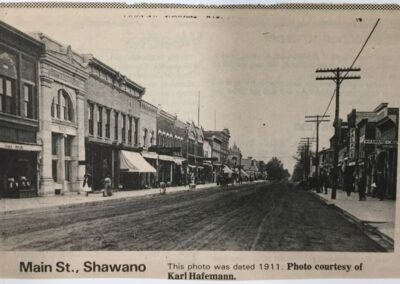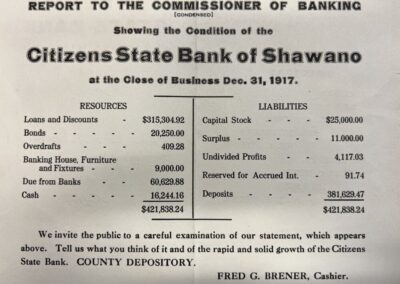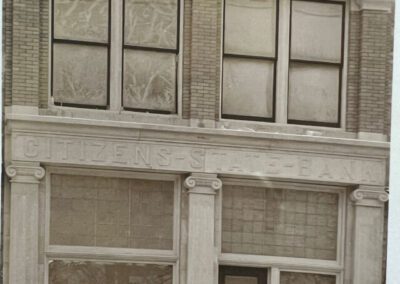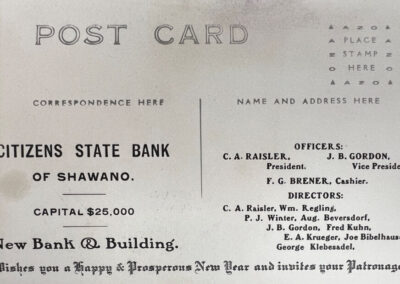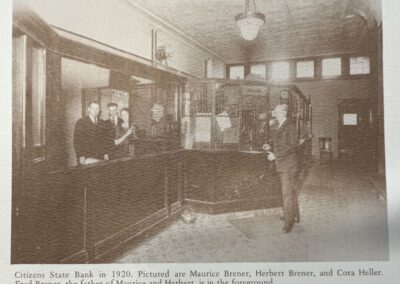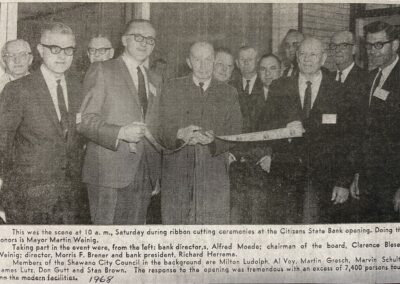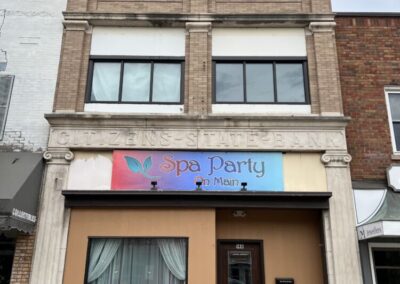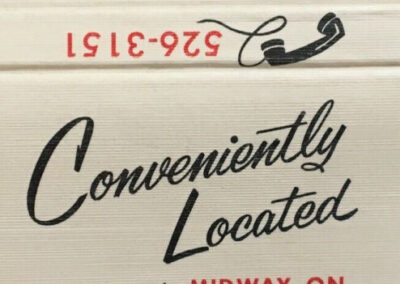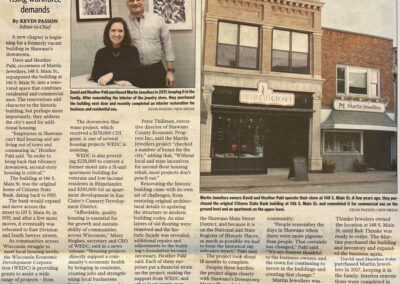Location
Photo Gallery
A Brief History
Citizens Bank
146 South Main Street
Shawano, Wisconsin
The Citizens State Bank of Shawano has a long history of progress and growth since it officially opened on March 10, 1910. Chartered by the State of Wisconsin the bank opened with a capital stock of $25,000 and at the conclusion of the first year, the bank’s total resources were more than $96,000.
THE FIRST quarters of the bank were located on the west side, in the 100 block of North Main Street. The first directors were C. A. Raisler, Paul J. Win-ter, E. A. Krueger, Fred Kuhn, August Beversdorf, William Reg-ling. George Klebesadel, Joseph Bibelhausen and John Gordon.
At the organizational session, the board of directors elected C. A. Raisler as president. John B. Gordon as vice president and Fred G. Brener as cashier. It was during the first year of business that the directors saw need for expansion and voted to construct a new bank, with the location in the 100 block of South Main Street, on the east side of the street at 146 S. Main Street.
Here is a reprint of the August 18, 1910 Shawano County Journal as the bank advertised for bids for the construction work of the new bank.
“Sealed bids will be received until 12 o’clock noon August 26th, 1910 for doing all labor and furnishing all material for a bank building to be erected for the Citizens State Bank of Shawano, Wis. according to plans and specifications on file with the Architect C. C. Fritz, Shawano, Wis., or at the bank. The mason and cut stone work may be let under separate contract; each bid must be accompanied with a certified check of 5 per cent of the amount of the bid. The right is reserved to reject any and all bids.”
Bids were opened and studied by bank officials, and on Thursday, September 1, 1910, the following notice was published, giving notice of the successful bidders:
“The bids for the construction of the new home for the Citizens State Bank were opened and the contracts awarded. The new bank will be a two story structure fronting on Main street, between Wavrunek’s harness shop and Miss Raddant’s millinery parlors. The proposed building will be built of stone and brick and will be about 65 × 30 feet in size. The contract for carpenter work was awarded to Christ Fritz of this city, and Haagourd & Madison of Suring was the successful bidder on stone and mason work. Bids for plumbing and wiring were received and laid over until next meeting. Work will be started immediately and all indications point to rapid completion of what promises to be one of the best and most substantial buildings in this city.”
Fred Brener served as cashier at the Citizens State Bank for eighteen years, until his death in January of 1928. His son, Morris Brener, then took over his father’s position at the bank as cashier, serving the firm in that capacity until his retirement in 1964. In all, Morris Brener served the bank for over fifty years, 36 years as head cashier. Mr. Raisler was president of the bank until he died in 1924. He was succeeded by Dr. Gordon who served in that capacity until 1937. Then a pioneer Shawano resident, and one of the original founders of the bank, Paul J. Winter, served numerous years in the position of bank president.
Mr. Winter retired as president in 1962, Morris Brener was elected president, serving until his retirement in 1964, at which time the present president, Rich-lard Herrema was elected to the position.
Citizens State Bank continued to progress and expand and in 1935 they sought larger quarters to handle their continuous increase in business.
ARRANGEMENTS were then completed for the site across the street, at 133 South Main Street. One pioneer resident recalls the day when the moving project was started. The bank hired Charles Ramlow with his sturdy team of horses and a stoneboat to haul the safe, safety boxes and other heavy equipment across the street to the new bank site.
In 1955 bank officials voted to expand more, and constructed an addition and completely remodeled the inside of the bank. As business continued to increase and new services offered to residents of Shawano and Shawano County, the bank periodically made the necessary improvements in their banking facilities. New Departments were added from time to time, including drive-in facilities.
Up until 1968, the bank made three moves, however, the biggest move of them all was to a new structure built at the corner of Division and Sawyer Streets. In all, the Citizens State Bank has served the Shawano County area until being taken over by Associated Bank.
From the 1999 National Register of Historic Places Registration application:
Built in 1910, this is the only contributing historic bank in the district (another is covered by a metal slipcover and is non-contributing at this time), the Citizens State Bank Building is a two-story, two-bay building with pressed metal cornice consisting of a simple architrave supported by singly-spaced dentils. The ends of the cornice are marked by upward-projecting semicircular shapes decorated with a sunburst motif. The center of the cornice has two smaller, semicircular sunbursts on either side and at the peak of a projecting triangle inscribed with the building’s date of construction. Beneath the cornice the upper facade is divided into two bays with three brick pilasters. The area beneath the cornice and above the second-story windows is set apart from the window area by a molded stone beltcourse, which also functions as the window’s lintels. The spaces between the piers in this area are marked by shallow brick corbels and slightly inset brick panels. The second floor window areas, defined above by the beltcourse mentioned previously; are marked on either side by the lower portions of the brick piers, each of which has a molded stone cap immediately below the belt course. A plain, stone beltcourse abuts the plain, stone bases of the piers, creating a second, continuous beltcourse that rests on top of the storefront’s entablature, described below. The two large glazed areas of the second floor have been replaced by smaller, non-historic windows, with the balance of the spaces filled by plain board. The storefront area is defined at either side by two Ionic stone pilasters. Each has wider flutes, a smaller capital and a taller, plain plinth that may be formally expected. The pilasters’ capitals support a simple entablature consisting of a wide frieze and simple molded cornice; the words “CITIZEN’S STATE BANK” is emblazoned in relief across the frieze. The transom light area below this entablature is intact but covered; the storefront area is entirely and unsympathetically altered.

